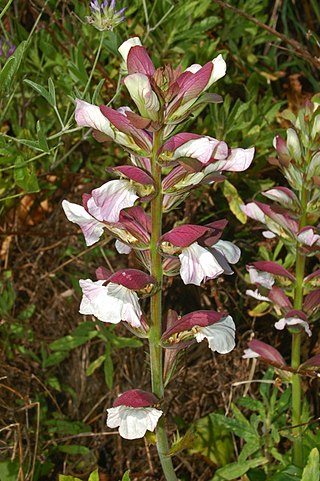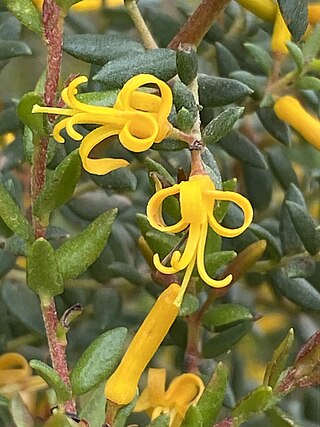
Acanthus mollis, commonly known as bear's breeches, sea dock, bear's foot plant, sea holly, gator plant or oyster plant, is a species of plant in the family Acanthaceae and is native to the Mediterranean region. It is a leafy, clump-forming perennial herb, with a rosette of relatively large, lobed or toothed leaves, and purplish and white flowers on an erect spike.

Persoonia, commonly known as geebungs or snottygobbles, is a genus of about one hundred species of flowering plants in the family Proteaceae. Plants in the genus Persoonia are shrubs or small trees usually with smooth bark, simple leaves and usually yellow flowers arranged along a raceme, each flower with a leaf or scale leaf at the base. The fruit is a drupe.

Acanthus is a genus of about 30 species of flowering plants in the family Acanthaceae, native to tropical and warm temperate regions, with the highest species diversity in the Mediterranean Basin and Asia. This flowering plant is nectar producing and depends on butterflies, such as Anartia fatima, and other nectar feeding organisms to distribute its pollen. Common names include Acanthus and bear's breeches. The generic name derives from the Greek term ἄκανθος (akanthos) for Acanthus mollis, a plant that was commonly imitated in Corinthian capitals.

Nepenthes mollis, or the velvet pitcher-plant, is a tropical pitcher plant species natives to Kalimantan, Borneo. It used to be known only from a single dried herbarium specimen and is the sole recognised species in the genus Nepenthes of which the pitchers are unknown. In 2019 Global Wildlife Conservation announced the rediscovery of the species.

Oenothera curtiflora, known as velvetweed, velvety gaura, downy gaura, or smallflower gaura, is a species of flowering plant native to the central United States and northern Mexico, from Nebraska and Wyoming south to Durango and Nuevo Leon.

Thomas Pennington Lucas, also known as T.P. Lucas, was a Scottish-born Australian medical practitioner, naturalist, author, philosopher and utopianist.

The soft-plumaged petrel is a species of seabird in the family Procellariidae.

Nudaria mundana, the muslin footman, is a moth of the subfamily Arctiinae. The species was first described by Carl Linnaeus in 1761. It is found in Europe and Anatolia.

Nudaria is a genus of moths in the subfamily Arctiinae erected by Adrian Hardy Haworth in 1809.

Grevillea mollis, commonly known as soft grevillea, is a species of flowering plant in the family Proteaceae and is endemic to a restricted area of north-eastern New South Wales. It is an open, spreading shrub with oblong to elliptic leaves and loose clusters of bright scarlet red flowers.

Australostichopus is a genus of sea cucumbers in the family Stichopodidae. It is monotypic, being represented by the single species Australostichopus mollis, commonly known as the brown sea cucumber or Australasian sea cucumber. This species has stimulated interest for its fishery potential in the Southern Hemisphere, and for its capability to reduce waste produced by aquaculture. Despite its ecological role and abundance in New Zealand coastal waters, the scarcity of knowledge regarding A. mollis biology and ecology has hindered the development of a stable fishery industry. Importantly, A. mollis represents promising business potential within an important Asian market. Recently its potential as a functional food has been evaluated, highlighting the nutritious components

Agonocheila is a genus in the beetle family Carabidae. There are more than 20 described species in Agonocheila.

Persoonia mollis, commonly known as soft geebung, is a plant in the family Proteaceae and is endemic to New South Wales. It is an erect to prostrate shrub with linear to oblong or spatula-shaped leaves, yellow flowers in groups of up to thirty on a rachis up to 150 mm (5.9 in) long and relatively small fruit.

Nudaria diaphanella is a moth of the subfamily Arctiinae first described by George Hampson in 1893. It is found in Sri Lanka.

Nudaria suffusa is a moth of the subfamily Arctiinae first described by George Hampson in 1894. It is found in the Indian states of Sikkim and Assam.

The Nudariina are a subtribe of lichen moths in the family Erebidae. The taxon was described by Carl Julius Bernhard Börner in 1920.

Elephantopus mollis, common names tobacco weed, and soft elephantsfoot, is a tropical species of flowering plant in the family Asteraceae.

Synallactida is a rankless clade of sea cucumbers, but is referred to as an order. Taxa within Synallactida were previously classified in an order called Aspidochirotida, which was determined to be polyphyletic in 2017.

Austrostipa mollis, also known as the soft speargrass or supple speargrass is a robust, erect tufted perennial speargrass in the Poaceae family. It is native to Australia, and found in Western Australia, South Australia, Victoria, ACT and Tasmania.
















